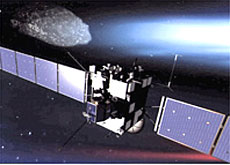Comet chaser takes off

Europe’s daring mission to land a robot on a comet has finally taken off.
Swiss scientists designed one of the instruments aboard the Rosetta spacecraft, which lifted off from Kourou in French Guiana at 8.17 CET.
“It’s a feeling of great relief and a lot of pleasure,” Peter Bochsler of Bern University told swissinfo.
“Many people have spent ten years of their scientific career preparing this instrument, so this really is the climax of our lives.”
The spacecraft was due to be launched early in 2003. However, the mission was delayed after a rocket similar to the one which would have launched Rosetta exploded at the launch site.
Because of the delay, Rosetta’s original quarry, Comet Wirtanen, had to be abandoned and the mission redesigned.
A first launch attempt last Thursday was scrapped because of high winds in the upper atmosphere. The second attempt was abandoned on Friday when a routine inspection found a technical problem.
Flagship mission
Rosetta is now heading for comet Churyumov-Gerasimenko, which it is due to meet in 2014, about 675 million kilometers from the Sun.
It will be the most detailed study of a comet ever undertaken and should reveal much about how the solar system formed.
“Rosetta is a flagship mission for the European Space Agency,” said Nicolas Thomas of Bern University who has been involved in the design of Rosetta’s main camera system.
“Cometary science is the one area where we have a lead over Nasa so it’s a very important mission for Europe.”
Comet Churyumov-Gerasimenko is a ball of ice, rock and dust which orbits the Sun once every 6.6 years.
No rocket today is powerful enough to hurl the craft on a direct route to the comet.
To get the required momentum, it will rely on swing-by manoeuvres, using the gravitation pull of Mars and the Earth to pick up speed.
High risk
Rosetta is due to meet the comet at its farthest point from the Sun.
Here in the cold parts of the solar system, Rosetta will try to land a robotic probe, named Philae, on the comet’s icy heart.
Released from Rosetta about a kilometre from the surface, the lander is expected to hit the nucleus and anchor itself to the ground.
The robot will send close-up pictures of the comet’s nucleus back to Earth and drill into the surface to sample its ices and gases
Meanwhile, Rosetta will continue to orbit Churyumov-Gerasimenko for the next 17 months as it hurtles towards the Sun.
The trip will end in December 2015 after the comet has made its closest approach to the Sun, before heading towards the outer Solar System.
“Even if the high-risk element, the lander, doesn’t come off then we can guarantee that we are going to get absolutely first rate science,” said Thomas.
“We can still take the orbiter down to one kilometre above the surface of the nucleus. It’s never been done before. It’s never even been dreamed of.”
Life on Earth
Comets are remnants from the birth of the solar system. They contain samples of the materials from which the Earth and the other planets were created 4.6 billion years ago.
Since then, matter on Earth and the other planets has been altered by geological, biological and chemical processes. But this hasn’t happened inside comets.
“The mission is basically going back into our deepest history,” said Thomas. “We are looking at the original material that came together to form our planetary system.”
Rosetta’s instruments will study the composition of the dust and gas released from the comet’s nucleus and help determine the role of comets in the origin of life on Earth.
Previous studies, notably by the European Space Agency’s Giotto spacecraft, have shown that comets contain complex organic molecules that are essential ingredients for life as we know it.
Radio contact
The Bern University team has designed and built of one of the experiments aboard the craft.
The Rosetta Orbiter Spectrometer for Ion and Neutral Analysis (Rosina) will use mass spectrometers to identify atoms, molecules and ions in the comet’s vapour.
At 35 kilograms, Rosina is the heaviest instrument on board apart from the lander. It was built in collaboration with eight institutes worldwide and cost about SFr60 million ($43.35 million).
All of the scientific data collected by the instruments on board the spacecraft are sent to Earth via a radio link. The operations centre remotely controls the spacecraft and its scientific instruments in the same way.
The mission is named after the Rosetta Stone, whose inscriptions helped unravel the secrets of ancient Egypt. Philae is the island in the River Nile on which the Rosetta Stone was found.
Scientists hope that Rosetta and Philae will provide similar insights into the ancient history of space and the planets.
swissinfo, Vincent Landon
Rosetta resembles a large aluminium box about 2.8 x 2.1 x 2.0 metres
It weighs three tons and has two 14-metre solar panels.
The scientific instruments are mounted on top.
The main craft is carrying 11 scientific instruments and the lander holds a further ten.
The mission has cost SFr1 billion.

In compliance with the JTI standards
More: SWI swissinfo.ch certified by the Journalism Trust Initiative








You can find an overview of ongoing debates with our journalists here . Please join us!
If you want to start a conversation about a topic raised in this article or want to report factual errors, email us at english@swissinfo.ch.